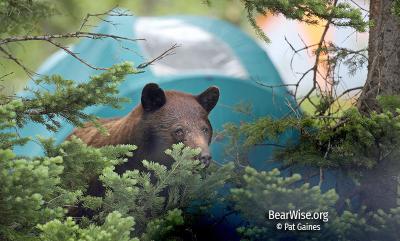Camping in Bear Country?
Camping in bear country? What to know before you go
Black bears live in at least 40 states and are seen in several more. If you’re heading out to get away from it all, chances are good you’re heading into bear country.
Teaching bears to associate cars, trails, campsites and people with food doesn’t just put a damper on your outdoor fun. It also creates unnecessary risk for you and your family and can have deadly consequences for bears. There are many simple steps you can take to avoid bear encounters and discourage bears from getting into your stuff.
Homework Now, Happy Trails Later
Food storage requirements and recommendations often vary by region and jurisdiction (national park, national forest, state lands, developed campgrounds and primitive sites). Pulling into your campsite or standing at the trailhead is not the time to discover you’re in active bear country and you left your bear spray and bear-resistant canister or cooler at home. Doing your homework and implementing BearWise practices now can help keep people and their stuff safe and bears wild.
Get bear-prepared before you leave. Read Vacationing in Bear Country and download the free Vacation Tips fact sheet.
When You Get There. Visitor centers often have trail maps, wildlife activity boards and are usually staffed with knowledgeable locals and volunteers familiar with trail conditions, campgrounds, closures and recent bear activity. You can also follow parks and forests on social media and sign up for alerts.
Lock It, Hide It Or Lose It
Leaving windows open and doors unlocked is an invitation to come on in and see if there’s anything good to eat. Black bears are very strong with nimble claws and can easily open most unlocked car doors or peel down a window that’s open just an inch or two. But once inside, bears often have to chew and claw their way out. Why take chances? Stash, roll up and lock up whenever you leave the car unattended.
Dogs In Bear Country
The safest thing for dogs, people and bears is to leave your dog at home. If your dog gets into an encounter with a black bear, odds are good it will be injured or killed. Don’t intervene; you will probably be injured as well. When a dog off leash encounters a bear, it usually runs back to safety (you), often followed by the bear. Keeping dogs on a short, non-retractable leash in camp and on the trail will help keep dogs, people and bears safe. For lots more info, download our free Dogs & Bears bulletin.
Car Camping?
Whether you’re in a well-developed campground or a drive-to site in the forest, if your car is nearby and local regulations permit, your locked vehicle can be a good place to store food, scented products and supplies. Store in a locked trunk and cover anything that a bear might be able to see through a window. Bears are very smart and often recognize coolers and grocery bags as good places to find food. If you must store stuff in an open pickup bed, invest in a sturdy bear-resistant cooler that can be secured in place.
Most developed campgrounds have hosts and bulletin boards with information and regulations, and often have wildlife sightings posted. Read when you arrive, and don’t forget to check the popular bathroom “bulletin board.”
A canister provides safe storage when camping (photo: BearVault)
Trekking Into The Backcountry?
Check with all agencies if your trail passes through multiple jurisdictions. National Scenic Trails like the Appalachian Trail and the Pacific Crest Trail have their own food storage regulations (visit their websites for advice).
Safe food storage is a must; losing all your food on day one will take all the fun out of a multi-day adventure. If you’re leaving your car in active bear country, double-check to be sure all windows and doors are closed and locked and anything you’re leaving behind is stored out of sight.
Earn The Clean Camp Award
Odors of all sorts attract bears. Whether you’re camping in the backcountry or frontcountry:
- Keep your tent scent-free. Bears will follow their noses to anything that smells as if it might be food. Store food, trash and scented products (including toiletries and the clothes you wore to cook or clean fish in) an approved bear-resistant locker or canister or properly hung according to local guidelines.
- Suspend food and scented stuff at least 10 feet above the ground and 10 feet from any part of the tree. Black bears are great climbers and can really stretch out if they think they can snag some food.
- Store sunscreen, bug spray or anything scented (including lip balm) far away from your tent. Resist the urge to go to sleep with a midnight snack tucked under your pillow. Keep a flashlight, whistle, air horn and bear spray in easy reach instead.
- Cook downwind and as far from your tent as practical. The gold standard is a 70-big-steps triangle between your sleeping, cooking and eating areas.
- Your fire ring or grill isn’t an incinerator. Don’t burn food scraps or trash; odors and residue will attract bears.
Frontcountry Or Backcountry, Carry Bear Spray
Bear spray has been proven to be the easiest and most effective way to deter an approaching bear. Local regulations on using bear spray may vary, so know before you go. Check out our Bear Spray page for how to (and how NOT to) use bear spray.
Camp BearWise. Keep Bears Wild.
BearWise®. Created by bear biologists. Supported by State Wildlife Agencies.
Dedicated to helping people live responsibly with black bears.
For additional information please visit the website of the author of this information www.BearWise.com



